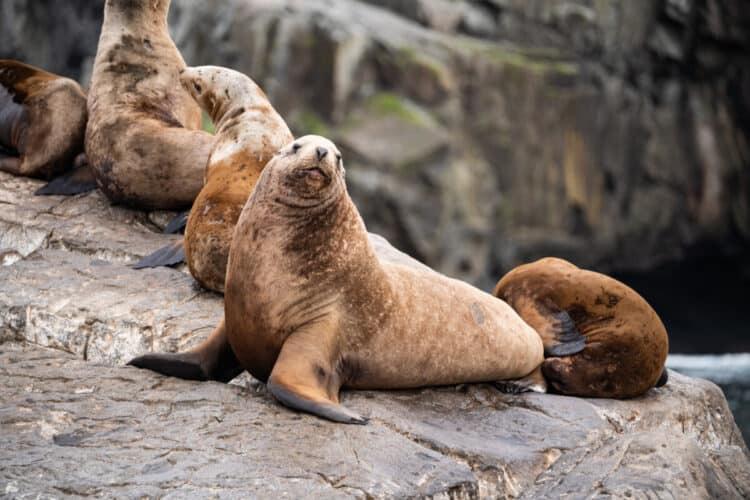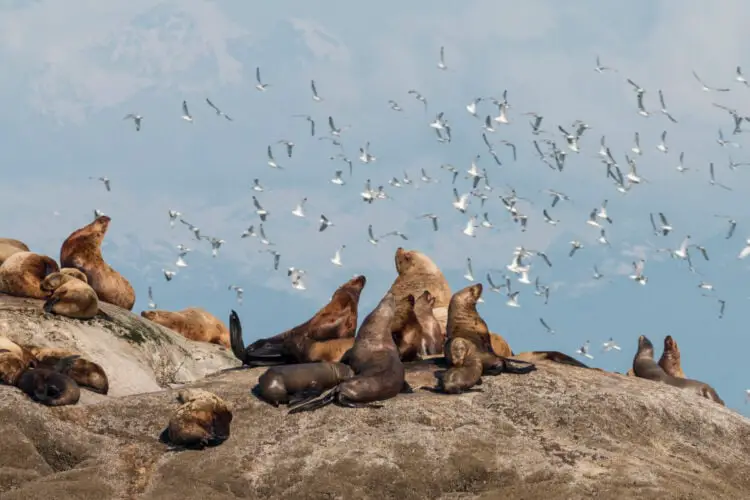The Steller sea lion, also known as the northern sea lion, is a species of marine mammal that inhabits coastal areas of the northern Pacific Ocean. This article aims to provide an objective and informative overview of the Steller sea lion, including its habitat and distribution, physical characteristics, feeding habits and diet, social behavior, and reproduction, threats faced by this species, conservation efforts implemented to protect it, as well as interesting facts about its biology.
Steller sea lions are primarily found along the coasts of Alaska in the United States and Russia’s Kuril Islands. They are known for their large size, with adult males reaching lengths up to 3 meters and weighing up to 1 ton. Their diet consists mainly of fish such as herring and salmon.
Understanding these aspects is crucial for conservation efforts aimed at protecting this vulnerable species. By providing an objective account of the Steller sea lion’s biology and highlighting both its natural history and potential threats it faces in its environment, this article seeks to contribute to scientific knowledge surrounding this fascinating marine mammal.

Habitat and Distribution
The habitat and distribution of Steller sea lions vary widely, as they can be found along the coastlines of the North Pacific Ocean, from northern Japan to California. These marine mammals exhibit migration patterns, where they travel long distances in search of food and breeding grounds.
During summer months, Steller sea lions migrate towards northern regions, such as Alaska and Russia, where food availability is higher. In winter, they move towards southern areas with milder temperatures. This migration behavior allows them to exploit different feeding opportunities throughout the year.
Adaptations to their marine environment include streamlined bodies and strong flippers for efficient swimming and maneuvering underwater. They also possess a thick layer of blubber that provides insulation against cold water temperatures. These adaptations enable Steller sea lions to thrive in their diverse habitats and successfully navigate through their vast distribution range in the North Pacific Ocean.
Physical Characteristics of Steller Sea Lions
Large marine mammals known for their impressive size and distinctive features, the physical characteristics of Steller sea lions include:
- A muscular build
- A thick layer of blubber for insulation
- Prominent whiskers
These sea lions are among the largest pinnipeds in the world, with adult males reaching lengths of up to 3 meters and weighing around 1,000 kilograms. Their muscular bodies enable them to swim swiftly through the water and navigate their rocky habitats with agility.
The thick layer of blubber provides insulation against cold temperatures and helps buoyancy in water.
Additionally, Steller sea lions possess long vibrissae or whiskers on their muzzle that aid in detecting prey and navigating underwater environments.
These physical attributes contribute to the survival and adaptability of Steller sea lions in their natural habitat.
Feeding Habits and Diet
The feeding habits and diet of Steller sea lions involve a diverse range of prey species, which contribute to their ecological role as top predators in their marine ecosystems. These marine mammals exhibit distinct foraging patterns, which vary depending on factors such as location and prey availability.
Steller sea lions primarily feed on a variety of fish species, including herring, salmon, and rockfish. They are also known to consume cephalopods such as squid and octopus. While they have a general preference for fish, their specific prey preferences may differ among individuals and populations due to local variations in prey abundance.
Steller sea lions use their highly developed swimming abilities and sharp teeth to capture and consume their prey efficiently. Understanding the feeding habits and diet of these marine mammals is crucial for conservation efforts aimed at preserving their populations and maintaining the balance of the marine ecosystems they inhabit.
Social Behavior and Reproduction
Social behavior and reproduction in Steller sea lions involve complex mating systems and hierarchical social structures. These sea lions exhibit polygynous mating, where dominant males establish territories and mate with multiple females.
Social dynamics within these groups are characterized by aggressive interactions between males competing for access to mates. Mating rituals include vocalizations, posturing, and displays of strength. Female choice also plays a role in the mating process, as they select mates based on factors such as size and dominance.
After successful copulation, female sea lions give birth to a single pup on land or ice floes. The bond between mother and pup is strong, with the mother providing care until the pup is weaned at around one year old.
Overall, understanding the social behavior and reproductive strategies of Steller sea lions contributes to our knowledge of their ecological adaptations and population dynamics.

Threats to Steller Sea Lions and Conservation Efforts
Threats to the conservation of Steller sea lions arise from factors such as predation, habitat loss, and human disturbances.
Overfishing poses a significant threat to these marine mammals. Steller sea lions rely on fish as their primary food source, and overfishing can lead to a depletion of their prey base. This can result in malnutrition and reduced reproductive success among the population.
Pollution is another concern for Steller sea lions. Chemical pollutants, such as oil spills and industrial waste, can contaminate their habitats and affect their health. These pollutants can accumulate in the tissues of sea lions through bioaccumulation, potentially leading to reproductive issues and compromised immune systems.
Conservation efforts aim to address these threats by implementing fishing regulations, reducing pollution sources, and establishing protected areas for species recovery.
Interesting Facts about Steller Sea Lions
The Steller sea lion, also known as the northern sea lion, faces various threats to its survival, including overfishing, habitat loss, and pollution. Conservation efforts have been implemented to protect this species and ensure its long-term viability.
However, it is important to also appreciate the unique characteristics and fascinating aspects of these marine mammals. Steller sea lions have an average life span of around 20-30 years in the wild. They are highly social animals that form large colonies on rocky shores or remote islands for breeding purposes.
The population size of Steller sea lions has seen fluctuations over time but is currently estimated at around 45,000 individuals worldwide. Understanding their lifespan and population dynamics is crucial for effective conservation management strategies aimed at preserving this remarkable species.

